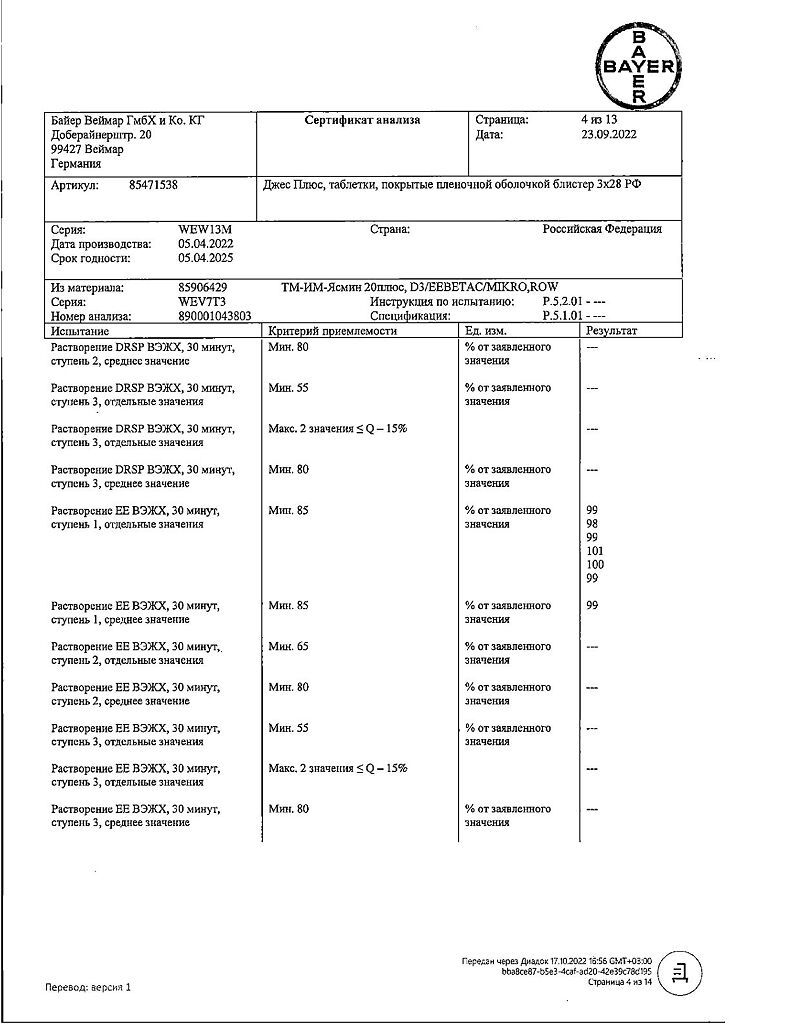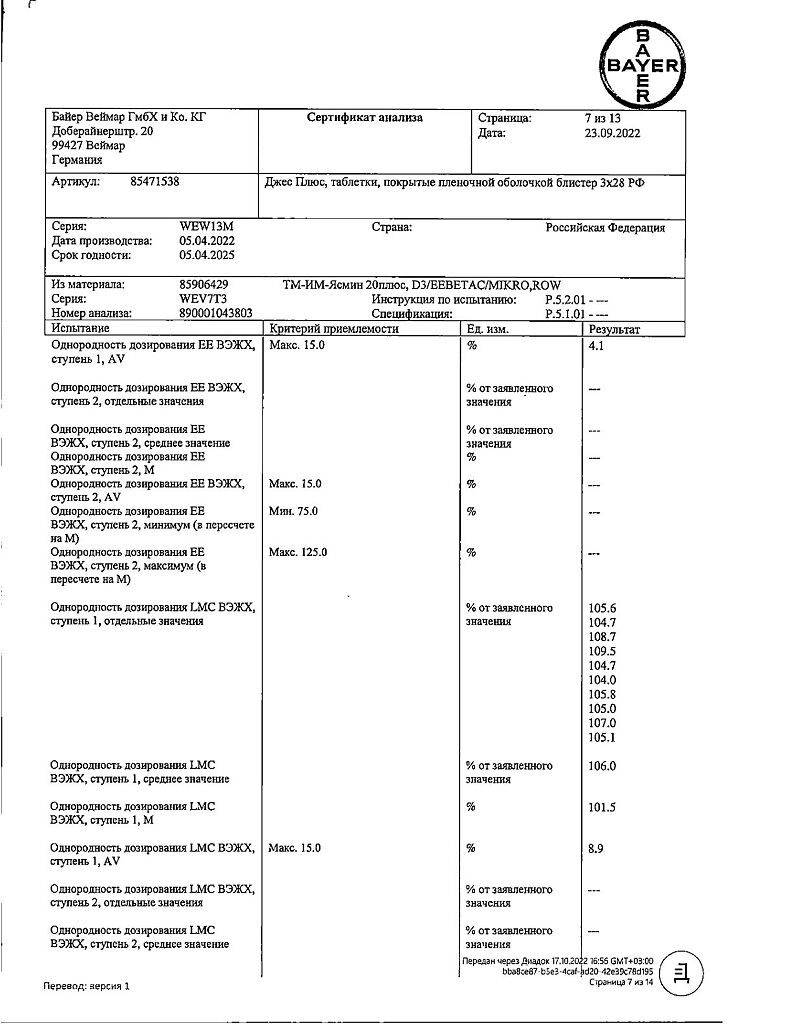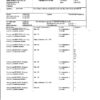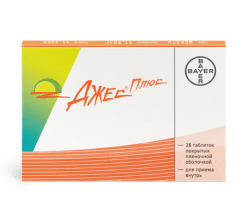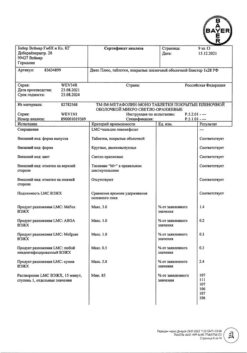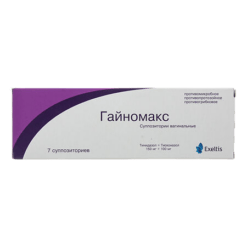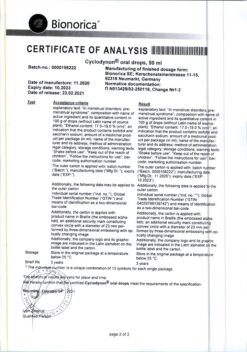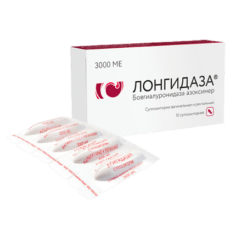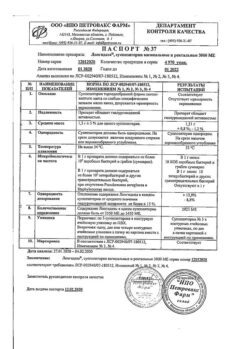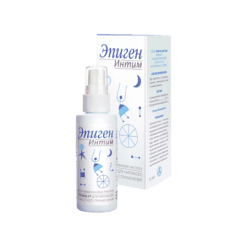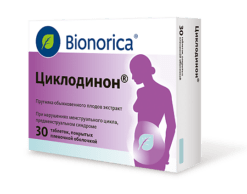No products in the cart.
Jess Plus, 84 pcs.
€93.29 €77.74
Description
Jes® Plus is a low-dose monophasic oral combined estrogen-gestogen contraceptive drug consisting of the active tablet and auxiliary tablets containing calcium levomepolate.
The contraceptive effect of Ges® Plus is mainly due to suppression of ovulation and increased viscosity of the cervical secretion.
Women taking combined oral contraceptives have more regular cycles, decreased pain, intensity, and duration of menstrual bleeding, and as a result, the risk of iron deficiency anemia decreases. There is also evidence of a decreased risk of endometrial and ovarian cancer.
Drospirenone, a component of the drug Jes® Plus, has antimineralocorticoid activity and helps prevent hormone-dependent fluid retention, which may be manifested by a reduction in body weight and a decrease in the likelihood of peripheral edema. Drospirenone also has anti-androgenic activity and helps to reduce acne (acne), oily skin and hair (seborrhea). These features of drospirenone should be considered when choosing a contraceptive for women with hormone-dependent fluid retention as well as for women with acne and seborrhea. In its characteristics drospirenone is similar to the natural progesterone produced by the female body. When used correctly, the Perl Index (a measure of the number of pregnancies in 100 women using the contraceptive in a year) is less than 1. If the pill is missed or used incorrectly, the Perl Index can increase.
The acidic form of calcium levomepholate, is identical in structure to naturally occurring L-5-methyltetrahydrofolate (L-5-methyl-TGF), the major folate form found in food. The average plasma concentration of L-5-methyltetrahydrofolate in people who do not eat foods fortified with folic acid is about 15 nmol/L.
Levomefolate, unlike folic acid, is a biologically active form of folate. Because of this, it is absorbed better than folic acid. Levomefolate is indicated for women during pregnancy and during breastfeeding to meet the increased need for folate. The addition of calcium levomepholate to an oral contraceptive reduces the risk of fetal neural tube defects if a woman becomes pregnant unexpectedly, immediately after discontinuation of contraception (or, in very rare cases, when oral contraception is used).
Indications
Indications
– contraception designed primarily for women with symptoms of hormone-dependent fluid retention;
– contraception and treatment for moderate acne (acne vulgaris);
– contraception in women with folate deficiency;
– contraception and treatment for severe premenstrual syndrome.
Composition
Composition
1 tablet – ethinylestradiol (micronized, in the form of betadex clathrate) 20 mcg;
drospirenone (micronized) – 3 mg;
calcium levomefolate (micronized) – 451 mcg.
Ancillary substances:
Lactose monohydrate – 45.329 mg,
Microcrystalline cellulose – 24.8 mg,
croscarmellose sodium – 3.2 mg,
hyprolose (5 cP) – 1.6 mg,
magnesium stearate – 1.6 mg.
Shell composition:
Pink varnish – 2 mg or (alternatively):
Hypromellose (5 cP) – 1.0112 mg,
macrogoal 6000 – 202.4 µg,
talc – 202.4 µg,
Titanium dioxide – 558 µg,
Red iron oxide dye – 26 µg.
How to take, the dosage
How to take, the dosage
The tablets should be taken orally in the order listed on the package, every day at the same time, without chewing, with a small amount of water. Take 1 tablet / day continuously for 28 days. The next pill in the pack should be taken right after the previous one is finished.
Bleeding withdrawal usually begins 2 to 3 days after starting the inactive pills and may not end until the pills from the next package start.
Packaging instructions for Jes® Plus
The unfolding package of Jes® Plus contains a blister containing 24 active (pink) tablets and 4 adjuvant (light orange) tablets (bottom row). The package also contains a block of stickers, consisting of 7 self-adhesive strips with the names of the days of the week marked on them, necessary for the design of the admission calendar.
Pick the strip with the first day of the week that you want the pills to start. For example, if your pills start on a Wednesday, use the strip that starts with Wed. The strip is glued along the top of the package so that the first day is above the pill to which the arrow labeled “Start” is pointing. This shows which day of the week each pill should be taken.
Start of the drug
If you have not taken any hormonal contraceptive in the previous month
Jes® Plus starts on day 1 of your menstrual cycle (that is, the first day of menstrual bleeding). On this day, you should take one pink (active) tablet, which is marked with the corresponding day of the week. Then you should take the pills in order. The product Jes® Plus takes effect immediately, so there is no need to use additional barrier methods of contraception.
The product may be started on days 2-5 of the menstrual cycle, but in this case an additional barrier method of contraception (for example, a condom) must be used during the first 7 days of taking the pink (active) pills from the first package.
When switching from other combined oral contraceptives, the vaginal ring, or the contraceptive patch
. It is preferable to start Ges® Plus the day after taking the last active tablet from the previous package, but in no case later than the day after the usual 7-day interval (for products containing 21 pills) or after taking the last inactive tablet (for products containing 28 pills in a package). The use of Jez® Plus should be started on the day the vaginal ring or patch is removed, but no later than the day on which a new ring or patch is to be inserted.
When switching from gestagen-only contraceptives (“mini-pills,” injectable forms, implant) or from a gestagen-releasing intrauterine therapeutic system
The It is possible to switch from the “mini-pill” to Ges® Plus on any day (without a break), from the implant or IUD with gestagen – on the day of their removal, from the injectable contraceptive – on the day when the next injection is to be made. In all cases, during the first 7 days of taking Ges® Plus it is necessary to use an additional barrier method of contraception (e.g., a condom).
After an abortion (including spontaneous) in the first trimester of pregnancy
The drug can be started immediately. No additional contraceptive measures are required if this condition is met.
After delivery (in the absence of breastfeeding) or abortion (including spontaneous abortion) in the second trimester of pregnancy
The initiation of the drug is recommended on day 21-28 after delivery or abortion (including spontaneous abortion) in the second trimester of pregnancy. If intake of the drug is started later, an additional barrier method of contraception should be used during the first 7 days of taking the pills. However, if sexual intercourse has taken place, pregnancy must be excluded before starting the use of Ges® Plus.
Missing pills
Missing auxiliary light orange pills can be ignored. However, missed pills should be discarded to avoid inadvertently prolonging the period of taking the booster pills. The following recommendations apply only to skipping the active pink tablets (tablets 1-24 in the pack).
If any pink (active) pill is missed for less than 24 hours, contraceptive protection is not reduced. A woman should take the missed pill as soon as possible and take the next ones at the usual time.
If any pink (active) pill is missed for more than 24 hours, contraceptive protection may be reduced. The more pills missed and the closer the missed pills are to the light orange (booster) pill phase, the greater the chance of pregnancy.
With this in mind:
– the drug should never be interrupted for more than 7 days (note that the recommended interval for taking the light orange (auxiliary) pills is 4 days);
– 7 days of continuous active (pink) pills are required to achieve adequate suppression of the hypothalamic-pituitary-ovarian system.
Accordingly, if the delay in taking the active (rose) pills was more than 24 hours, the following can be recommended:
From day 1 to day 7
The woman should take the last missed pill as soon as she remembers it, even if this means taking two pills at the same time. The next pills should be taken at the usual time. In addition, an additional barrier method of contraception (such as a condom) must be used for the next 7 days. If sexual intercourse took place in the 7 days before skipping the pill, you should consider the possibility of pregnancy.
From day 8 to day 14
The woman should take the last pill she missed as soon as she remembers it, even if that means taking two pills at once. She continues to take the next pill at the usual time.
If the pill regimen is followed for the 7 days preceding the first missed pill, no additional contraceptive measures are necessary. Otherwise, and if two or more pills are missed, additional barrier methods of contraception (such as a condom) should be used for the next 7 days.
From day 15 to day 24
The risk of decreased contraceptive reliability is inevitable because of the approaching phase of taking the light orange (booster) pills. In this case, the following algorithms should be followed:
If all pills were taken correctly in the 7 days preceding the first missed pill, there is no need to use additional contraceptive methods. For missed pills, use either 1 or 2;
If the pills were not taken correctly in the 7 days before the first missed pill, additional barrier methods of contraception (such as a condom) must be used for the next 7 days, in which case use of item 1 for the missed pills must be followed.
1. Take the missed pill as soon as possible as soon as the woman remembers it (even if it means taking two pills at once). The next pills are taken at the usual time until the pink (active) pills in the package run out. The four light orange (helpers) tablets should be discarded and the pink (active) tablets in the new pack should be taken immediately. Until the pink (active) pills in the second pack are finished, bleeding cancellation is unlikely, but there may be oozing and/or breakthrough bleeding.
2. Interrupt the pink (active) pills in the current package, then take a break for 4 days or less (including days of missed pills), and then start the new package.
If a woman has missed the pink (active) pills and no bleeding cancellation has occurred while taking the light orange (adjuvant) pills, you should make sure there is no pregnancy.
A maximum of two pills can be taken in one day.
Recommendations for gastrointestinal disorders
In severe gastrointestinal disorders, absorption of the drug may be incomplete, so additional contraceptive measures should be taken.
If vomiting or diarrhea occurs within 3-4 hours of taking the pink (active) pill, the recommendations for skipping the pill should be followed. If a woman does not want to change her usual regimen and postpone the start of her period to another day of the week, the additional pink (active) pill should be taken from a different package.
To stop taking Des® Plus
The use of Des® Plus can be stopped at any time. If a woman is not planning a pregnancy, other contraceptive methods should be taken care of. If a pregnancy is planned, you should simply stop taking Des® Plus, wait until your natural menstrual bleeding, and then try to get pregnant. This will help to calculate the timing of pregnancy and delivery more accurately.
To delay the onset of menstrual bleeding, you can skip the 4 light orange (booster) pills in your current dose and start the pink (active) pills in your next dose of Jes® Plus. If all 24 pink tablets of the second package have been taken, in this case you should also take 4 light orange tablets. Only then can you start taking the pills from the new pack. In this way the cycle can be prolonged, if desired, for up to 3 weeks, including until all the pink pills from the second package have been taken. If you want your menstrual bleeding to start sooner, you should stop taking the pink pills from the second package, discard it and take a break of no more than 4 days from all the pills, then start taking the pills from the new package. In this case, menstrual bleeding will begin approximately 2-3 days after taking the last pink pill from the second pack. During taking Jes® Plus from the second package, menstrual discharge and/or breakthrough bleeding may occur on the days the pills are taken.
Changing the start day of menstrual bleeding
If the pills are taken as recommended, menstrual bleeding will occur on about the same day every 4 weeks. If a woman wants to change the day her menstrual bleeding starts, you should stop taking the light orange pills for as many days as the woman wants to change the start of her menstrual bleeding. For example, if your cycle usually starts on Friday, but you want it to start on Tuesday (three days earlier), you can start taking the pills from the next package three days earlier, that is, skip the last three light orange pills of your current cycle and start taking pills from the next package. The less light orange pills the woman takes, the higher the probability that menstrual bleeding will not occur. While taking Jes® Plus from the next package, you may experience menses and/or breakthrough bleeding.
The efficacy and safety of Jes® Plus as a contraceptive has been studied in women of reproductive age. The use of the drug in children and adolescents is contraindicated until regular menstrual cycles are established.
Jes® Plus is not used after the onset of menopause.
The drug is contraindicated in women with severe hepatic impairment.
The drug is contraindicated in women with severe renal dysfunction and acute renal failure.
Interaction
Interaction
The effect of other drugs on the drug Jes® Plus
Possible interaction with drugs that induce microsomal liver enzymes may result in increased clearance of sex hormones, which in turn may lead to breakthrough uterine bleeding and/or decreased contraceptive effect.
Women who are treated with these drugs in addition to Ges® Plus are advised to use a barrier method of contraception or choose another non-hormonal contraceptive method. A barrier method of contraception should be used during the entire period of use of concomitant drugs, and for 28 days after their withdrawal. If the barrier method of contraception ends later than the pink (active) tablets in the package of Jez® Plus, you should skip the light orange (adjuvant) tablets and start taking the tablets from the new package of Jez® Plus.
Medications that increase clearance of Ges® Plus (which weaken effectiveness by inducing enzymes): phenytoin, barbiturates, primidone, carbamazepine, rifampicin, and possibly also oxcarbazepine, topiramate, felbamate, griseofulvin, and preparations containing St John’s wort.
Many HIV or hepatitis C virus protease inhibitors and non-nucleoside reverse transcriptase inhibitors can increase or decrease plasma concentrations of estrogen or progestins when used with Jez® Plus. In some cases this effect can be clinically pronounced.
Medications that reduce the effectiveness of calcium levomepolate: Some drugs reduce plasma folate concentrations and decrease folate efficacy by inhibiting the dihydrofolate reductase enzyme (e.g., methotrexate, trimethoprim, Sulfasalazine and triamterene) or by reducing folate absorption (e.g., colestyramine) or by unknown mechanisms (e.g., the antiepileptic drugs carbamazepine, phenytoin, phenobarbital, primidone and valproic acid).
Medications that reduce the clearance of combined oral contraceptives (enzyme inhibitors): Strong to moderate CYP3A4 inhibitors, such as azole-group antifungals (e.g., itraconazole, voriconazole, fluconazole), verapamil, macrolide-group antibiotics (e.g., clarithromycin, erythromycin), diltiazem and grapefruit juice may increase plasma concentrations of estrogen or progestin, or both.
Etoricoxib at doses of 60 and 120 mg/day when combined with combined oral contraceptives containing 0.035 mg ethinylestradiol has been shown to increase plasma concentrations of ethinylestradiol by 1.4 and 1.6 times, respectively.
The effect of combined oral contraceptives or calcium levomepholate on other drugs
The combined oral contraceptives may affect the metabolism of other drugs, resulting in an increase (e.g., cyclosporine) or decrease (e.g., lamotrigine) in their plasma and tissue concentrations.
In vitro drospirenone is able to slightly or moderately inhibit the cytochrome P450 enzymes CYP1A1, CYP2C9, CYP2C19 and CYP3A4.
Based on in vivo interaction studies in female volunteers taking omeprazole, simvastatin, or midazolam as marker substrates, we can conclude that clinically significant effects of 3 mg drospirenone on drug metabolism mediated by cytochrome P450 enzymes are unlikely.
In vitro, ethinylestradiol is a reversible inhibitor of CYP2C19, CYP1A1 and CYP1A2 and an irreversible inhibitor of CYP3A4/5, CYP2C8 and CYP2J2. In clinical trials, administration of a hormonal contraceptive containing ethinylestradiol has resulted in no or only a slight increase in plasma concentrations of CYP3A4 substrates (e.g., midazolam), whereas plasma concentrations of CYP1A2 substrates may increase slightly (e.g., theophylline) or moderately (e.g., melatonin and tizanidine).
The folate may modify the pharmacokinetics or pharmacodynamics of some drugs that influence folate metabolism, e.g., antiepileptic drugs (phenytoin), methotrexate or pyrimethamine, which may be accompanied by a decrease (generally reversible if the dose of the folate-improving drug is increased) in their therapeutic effect. Administration of folate against the background of treatment with these drugs is recommended mainly to reduce the toxicity of the latter.
Special Instructions
Special Instructions
If any of the conditions, diseases, and risk factors listed below are present, the potential risks and expected benefits of the use of Ges® Plus should be carefully weighed on an individual basis and discussed with the woman before she decides to start taking this medication.
Cardiovascular disease
The results of epidemiologic studies suggest that the use of Des Des® Plus may not be safe. Epidemiologic studies suggest an association between use of combined oral contraceptives and increased incidence of venous and arterial thrombosis and thromboembolism (such as deep vein thrombosis, pulmonary embolism, myocardial infarction, and cerebrovascular events) when taking combined oral contraceptives. These diseases are rare.
The risk of venous thromboembolism (VTE) is highest in the first year of combined oral contraceptive use. An increased risk is present after initial use of combined oral contraceptives or renewed use of the same or different combined oral contraceptives (after a gap of 4 weeks or more between doses). Data from a large prospective study involving 3 groups of patients show that this increased risk is predominantly present during the first 3 months.
The overall risk of VTE in patients taking low-dose combination oral contraceptives (< 50 µg ethinylestradiol) is 2-3 times higher than in nonpregnant patients not taking combined oral contraceptives, yet this risk remains lower compared with the risk of VTE in pregnancy and childbirth.
VTE can be life-threatening or fatal (1-2% of cases).
VTE, manifesting as deep vein thrombosis or pulmonary embolism, can occur with any combination oral contraceptive.
It is extremely rare for thrombosis of other blood vessels, such as hepatic, mesenteric, renal, cerebral veins and arteries, or retinal vessels, to occur with combined oral contraceptives.
The symptoms of deep vein thrombosis (DVT) include unilateral swelling of the lower extremity or along the vein of the lower extremity, pain or discomfort in the lower extremity only when upright or walking, localized temperature rise in the affected lower extremity, redness or discoloration of the skin on the lower extremity.
The symptoms of pulmonary artery thromboembolism (TELA) include difficulty or rapid breathing; sudden cough, including coughing with hemoptysis; sharp chest pain, which may increase with deep breaths; anxiety; severe dizziness; and rapid or irregular heartbeat. Some of these symptoms (e.g., shortness of breath, coughing) are nonspecific and may be misinterpreted as signs of other more or less severe events (e.g., respiratory tract infection).
Arterial thromboembolism can lead to stroke, vascular occlusion, or myocardial infarction.
Stroke symptoms: Sudden weakness or loss of sensation in the face, upper or lower extremities, especially on one side of the body, sudden confusion, problems with speech and comprehension; sudden one- or two-sided loss of vision; sudden gait disturbance, dizziness, loss of balance or coordination of movements; sudden, severe or prolonged headache without apparent cause; loss of consciousness or fainting with or without an epileptic seizure.
Other signs of vascular occlusion: sudden pain, swelling and mild bruising of the extremities, “acute abdomen” symptomcomplex.
Symptoms of myocardial infarction: pain, discomfort, pressure, heaviness, feeling of tightness or distension in or behind the chest and radiating to the back, jaw, left upper extremity, epigastrium; cold sweat, nausea, vomiting or dizziness, marked weakness, anxiety or dyspnea; palpitations that are rapid or irregular.
Arterial thromboembolism can be life-threatening or fatal.
In women with a combination of several risk factors or high severity of one of them (e.g., complicated valvular heart disease, uncontrolled arterial hypertension, extensive surgery with prolonged immobilization, and others), their synergistic potential should be considered. In such cases, the cumulative value of the existing risk factors increases. In this case the use of Ges®Plus is contraindicated.
The risk of thrombosis (venous and/or arterial) and thromboembolism or cerebrovascular disorders increases:
– with age;
– in smokers (the risk increases with more cigarettes or greater age, especially in women over 35);
when:
– obesity (BMI greater than 30 kg/m2);
– indications in family history (e.g., venous or arterial thromboembolism ever in a close relative or parent at a relatively young age). In case of any hereditary or acquired predisposition, a woman should be examined by an appropriate specialist to decide whether she should take Des® Plus;
– prolonged immobilization, major surgery, any lower extremity surgery or extensive trauma. In these situations, it is advisable to discontinue Ges® Plus (in the case of planned surgery, at least 4 weeks before) and not to resume use for 2 weeks after the end of immobilization. Temporary immobilization (e.g., a flight longer than 4 hours) may also be a risk factor for venous thromboembolism, especially if other risk factors are present;
– dyslipoproteinemia;
– arterial hypertension;
– migraine;
– heart valve disease;
– atrial fibrillation.
The possible role of varicose veins and superficial thrombophlebitis in venous thromboembolism remains controversial.
The increased risk of thromboembolism in the postpartum period should be considered.
Peripheral circulatory disorders may also be seen in diabetes mellitus, systemic lupus erythematosus, hemolytic uremic syndrome, chronic inflammatory bowel disease (Crohn’s disease or ulcerative colitis) and sickle cell anemia.
An increase in the frequency and severity of migraine during the use of Jes®Plus (which may precede cerebrovascular disorders) is grounds for immediate withdrawal of the drug.
The biochemical indicators indicating an inherited or acquired predisposition to venous or arterial thrombosis include the following: Activated protein C resistance, hyperhomocysteinemia, antithrombin III deficiency, protein C deficiency, protein S deficiency, antiphospholipid antibodies (antibodies to cardiolipin, lupus anticoagulant).
When evaluating the risk-benefit ratio, it should be considered that adequate treatment of the condition in question may reduce the associated risk of thrombosis. It should also be considered that the risk of thrombosis and thromboembolism in pregnancy is higher than with low-dose oral contraceptives (< 50 mcg ethinylestradiol).
Tumors
The most significant risk factor for cervical cancer is persistent papillomavirus infection. There have been reports of some increased risk of cervical cancer with long-term use of combined oral contraceptives. However, the association with taking combined oral contraceptives has not been proven. The possibility of an association of these findings with cervical disease screening and with patterns of sexual behavior (less frequent use of barrier methods of contraception) is discussed.
A meta-analysis of 54 epidemiological studies showed that there is a slightly increased relative risk of breast cancer diagnosed in women currently taking combined oral contraceptives (relative risk 1.24). The increased risk gradually disappears within 10 years of stopping these drugs. Because breast cancer is rare in women under 40 years of age, the increase in breast cancer diagnoses in women currently or recently taking the combined oral contraceptives is small relative to the overall risk of the disease. It has not been proven to be associated with taking the combined oral contraceptives. The observed increase in risk may be a consequence of close monitoring and earlier diagnosis of breast cancer in women using combined oral contraceptives. Women who have ever used combined oral contraceptives are found to have earlier stages of breast cancer than women who have never used them.
In rare cases, development of benign and, in extremely rare cases, malignant hepatic neoplasms has been observed with combined oral contraceptives, which in some patients led to life-threatening intra-abdominal bleeding.
If severe abdominal pain, enlargement of the liver, or signs of intra-abdominal bleeding occur, this must be considered when making a differential diagnosis.
Other conditions
Clinical studies have shown no effect of drospirenone on plasma potassium concentrations in patients with mild to moderate renal impairment. However, in patients with impaired renal function and baseline potassium concentration at ICH, the risk of hyperkalemia with the use of drugs that lead to potassium retention in the body cannot be excluded.
Women with hypertriglyceridemia (or a family history of this condition) may have an increased risk of pancreatitis while taking combined oral contraceptives.
While small increases in BP have been described in many women taking combined oral contraceptives, clinically significant increases have been rare. However, if a persistent, clinically significant increase in BP develops while taking Jes® Plus, the drug should be discontinued and treatment for arterial hypertension should be initiated. The drug can be continued if normal BP values are achieved with hypotensive therapy.
The following conditions have been reported to develop or worsen both during pregnancy and while taking combined oral contraceptives, but their association with taking combined oral contraceptives has not been proven: Jaundice and/or pruritus associated with cholestasis; gallstone formation; porphyria; systemic lupus erythematosus: hemolytic-uremic syndrome; Sydenham’s chorea; pregnancy herpes; hearing loss associated with otosclerosis. There have also been described cases of worsening the course of Crohn’s disease and ulcerative colitis, endogenous depression, epilepsy against the background of combined oral contraceptives.
In women with hereditary forms of angioedema, exogenous estrogens may cause or worsen symptoms of angioedema.
Acute or chronic liver dysfunction may require discontinuation of Jes® Plus until liver function returns to normal. Recurrent cholestatic jaundice, which develops for the first time during pregnancy or previous use of sex hormones, requires discontinuation of Jes® Plus.
While combined oral contraceptives may affect insulin resistance and glucose tolerance, hypoglycemic dose adjustments in diabetic patients using low-dose combined oral contraceptives (< 50 mcg ethinylestradiol) are generally not necessary. However, women with diabetes mellitus should be carefully monitored while using combined oral contraceptives.
Chloasma can sometimes develop, especially in women with a history of pregnancy chloasma. Women who are prone to chloasma should avoid prolonged sun exposure and exposure to ultraviolet radiation while taking the drug Jes® Plus.
The folate may mask vitamin B12 deficiency.
Preclinical safety data
Preclinical data from standard studies for multiple-dose toxicity, genotoxicity, carcinogenic potential, and reproductive toxicity indicate no particular risk to humans. However, we should keep in mind that sex hormones can promote the growth of some hormone-dependent tissues and tumors.
Preclinical data from standard studies of calcium levomepholate for multiple-dose toxicity and genotoxicity and reproductive toxicity do not indicate a particular risk to humans.
Laboratory tests
The administration of Jez® Plus may affect the results of some laboratory tests, including liver, kidney, thyroid, and adrenal function, plasma transport protein concentrations, carbohydrate metabolism, and clotting and fibrinolysis parameters. The changes usually do not go beyond the normal values. Drospirenone increases plasma renin activity and aldosterone concentration, which is associated with its anti-mineralocorticoid effect.
The efficacy of Jes® Plus may be reduced in the following cases: skipping pink (active) pills, gastrointestinal distress while taking pink (active) pills, or as a result of drug interactions.
The frequency and severity of menstrual bleeding
An irregular (acyclic) vaginal bleeding (spotting and/or breakthrough uterine bleeding) may occur during the first few months of taking Jes® Plus. You should use hygiene products and continue taking the pills as usual. Any irregular bleeding should be evaluated after an adjustment period of approximately three cycles.
If irregular bleeding recurs or develops after previous regular cycles, a thorough evaluation should be performed to rule out malignancy or pregnancy.
Lack of regular menstrual bleeding
Some women may not develop a bleeding discontinuation while taking the supportive light orange pills. If Jes® Plus was taken as recommended, it is unlikely that the woman is pregnant. However, if Jes® Plus is used irregularly and no two consecutive bleeding cancellations occur, the medication cannot be continued until pregnancy is ruled out.
Medical examinations
Before starting or resuming use of the drug, a woman’s medical history, family history, a thorough physical examination (including measurement of BP, heart rate, BMI, breast examinations), a gynecological examination, a cervical cytology (Papanicolaou test), and pregnancy should be performed. If you resume taking Ges® Plus, the scope of additional examinations and the frequency of check-ups are determined individually, but at least once every 6 months.
The woman should be warned that the medication Jes® Plus does not protect against HIV infection and other sexually transmitted diseases.
Conditions requiring medical advice
Any change in health, especially the occurrence of the conditions listed under “Contraindications” and “Caution;
A localized thickening in the breast;
At the same time as other medications (see “Drug Interactions”).
If prolonged immobility is expected (for example, the lower extremity is in a cast), or if hospitalization or surgery is planned (at least 4 weeks before the anticipated surgery). – The pill was missed in the first week of the bottle and there was sexual intercourse for 7 days or less before that time;
If I do not have another menstrual bleeding for 2 consecutive periods or I suspect pregnancy (you should not start the pills from the next bottle until you have talked to your doctor).
The pills should be stopped and a doctor should be consulted immediately if there are possible signs of thrombosis, myocardial infarction, or stroke: unusual cough; unusually severe pain behind the sternum, extending to the left arm; sudden shortness of breath, unusual, severe and prolonged headache or migraine attack; partial or complete loss of vision or double vision; slurred speech; sudden changes in hearing, smell or taste; dizziness or fainting; weakness or loss of sensation in any part of the body; severe abdominal pain; severe pain in a lower extremity or sudden swelling in either lower extremity.
Impact on driving and operating ability
There have been no reports of adverse effects of Jes® Plus on psychomotor reaction speed; there have been no studies of the effect of the drug on psychomotor reaction speed.
Contraindications
Contraindications
Ges® Plus is contraindicated in the presence of any of the conditions/diseases listed below. If any of these conditions/diseases develop for the first time while taking the drug, it should be stopped immediately.
– Thrombosis (venous and arterial) and thromboembolism at present or in the history (including deep vein thrombosis, pulmonary embolism, myocardial infarction, stroke), cerebrovascular disorders;
– conditions preceding thrombosis (including transient ischemic attacks, angina pectoris) currently or in the history;
– an identified acquired or hereditary predisposition to venous or arterial thrombosis, including resistance to activated protein C, antithrombin III deficiency, protein C deficiency, protein S deficiency, hyperhomocysteinemia, antibodies to phospholipids (antibodies to cardiolipin, lupus anticoagulant);
– presence of high risk of venous or arterial thrombosis;
– migraine with focal neurologic symptoms currently or in history;
– pancreatitis with significant hypertriglyceridemia currently or in history;
– diabetes mellitus with vascular complications;
– liver failure and severe liver disease (until normalization of liver tests);
– liver tumors (benign or malignant), current or anamnesis;
– severe and/or acute renal failure;
– identified hormone-dependent malignant neoplasms (includingÑ.
– any suspected or suspected malignancy (including genital or mammary glands);
– bleeding from the vagina with unclear genesis;
– pregnancy or suspected pregnancy;
– breastfeeding period;
– rare hereditary lactose intolerance, lactase deficiency, or glucose-galactose malabsorption (due to lactose content);
– hypersensitivity or intolerance to any component of the product Jes® Plus.
With caution
The potential risks and expected benefits of the use of the drug Jes® Plus should be evaluated in each individual case in the presence of the following diseases/conditions and risk factors:
– risk factors for thrombosis and thromboembolism: Smoking, obesity, dyslipoproteinemia, controlled arterial hypertension, migraine without focal neurologic symptoms, uncomplicated heart valve defects, hereditary predisposition to thrombosis (thrombosis, myocardial infarction or cerebral circulation disorders at a young age in any of the immediate family members);
– other conditions in which peripheral circulatory disorders may be noted: diabetes mellitus without vascular complications, systemic lupus erythematosus, hemolytic-uremic syndrome, Crohn’s disease and ulcerative colitis, sickle cell anemia, superficial vein phlebitis;
– hereditary angioedema;
– hypertriglyceridemia;
– liver diseases that are not contraindications;
– diseases that first appeared or worsened during pregnancy or on previous use of sex hormones (e.g., jaundice and/or pruritus associated with cholestasis, cholelithiasis, otosclerosis with hearing impairment, porphyria, herpes of pregnancy, Sydenham’s chorea);
– Postpartum period (not before 21-28 days after delivery, if breastfeeding is absent).
Side effects
Side effects
The most common adverse reactions reported in relation to the use of the drug are: nausea, breast pain, irregular uterine bleeding, and unspecified genital bleeding (in more than 3% of women using the drug for the indications “Contraception” and “Contraception and treatment of moderate acne (acne vulgaris)”) nausea, mammary gland pain, and irregular uterine bleeding (in more than 10% of women using the drug for the indication “Contraception and treatment of severe premenstrual syndrome (PMS)”).
Serious adverse reactions are arterial and venous thromboembolism.
The following is the incidence of adverse reactions reported in clinical trials of Ges® and Ges® Plus for the indication “Contraception” as well as for “Contraception and treatment of moderate acne (acne vulgaris)” (n=3565) and “Contraception and treatment of severe premenstrual syndrome (PMS)” (n=289) for the drug Ges®. Within each group, separated according to frequency of occurrence, adverse reactions are presented in decreasing order of severity. They are divided by frequency as follows: frequently (â¥1/100 and < 1/10), infrequently (â¥1/1000 and < 1/100), and rarely (â¥1/10,000 and < 1/1000). For additional adverse reactions identified only during post-marketing surveillance and for which it was not possible to estimate the frequency of occurrence, “frequency unknown” is indicated.
Infectious and parasitic diseases: rarely – candidiasis.
Metabolism and nutrition: infrequent – weight gain; rarely – weight loss, increased appetite, anorexia, hyperkalemia, hyponatremia.
Psychiatric disorders: often – mood swings; infrequent – decreased or lost libido2, somnolence, depression/ depressed mood; rarely – anorgasmia, insomnia.
Nervous system disorders: frequently – headache; infrequently – dizziness, paresthesia.
The cardiovascular system: infrequent – increase in BP, migraine; rare – tachycardia, venous and arterial thromboembolism *, syncope, nose bleeds.
An organ of vision: rarely – conjunctivitis, dry mucous membrane of the eye, visual impairment.
Gastrointestinal disorders: frequently – nausea1; infrequently – abdominal pain, vomiting, gastritis, diarrhea, dyspepsia, flatulence; rarely – bloating, constipation, dry mouth.
Liver and biliary tract disorders: rarely – pain in the right subcostal area.
The immune system: rare – allergic reactions; frequency unknown – hypersensitivity.
Skin and subcutaneous tissue: infrequent – acne, itching, rash; rarely – alopecia, hypertrichosis, eczema, dry skin, contact dermatitis, acneiform dermatosis; frequency unknown – erythema multiforme.
Muscular system disorders: infrequent back pain, pain in the extremities, muscle cramps.
Gender and mammary system disorders: frequent – pain in the mammary glands1, mammary gland soreness, acyclic bloody discharge/bleeding from the vagina1, bleeding from the genital tract of unspecified genesis, absence of menstrual-like bleeding; infrequent – pelvic pain, “hot flashes”, cystic fibrosis, candidiasis vulvovaginitis, vaginal discharge, heavy menstrual bleeding, scanty menstrual bleeding-like discharge, rare menstrual bleeding, painful menstrual bleeding, dry vaginal mucosa, pathological Papanicolae test result; rarely – mammary gland hyperplasia, cervical polyp, ovarian cysts, endometrial atrophy.
Hematopoietic system: rarely – anemia, thrombocythemia.
Otherwise: infrequent – asthenia, increased sweating, generalized or peripheral edema; rarely – malaise.
The adverse events were classified using the MedDRA dictionary. Different MedDRA terms reflecting the same symptom were grouped together and presented as a single adverse reaction to avoid diluting or blurring the true effect.
* Approximate frequency from epidemiologic studies covering a group of combined oral contraceptives. The frequency bordered on the very rare.
– “Venous or arterial thromboembolism” includes the following nosological units: peripheral deep vein occlusion, thrombosis and embolism / pulmonary occlusion, thrombosis, embolism and infarction / myocardial infarction / cerebral infarction and hemorrhagic stroke.
1 Frequency of cases in studies evaluating PMS was very frequent >10/100
2 Frequency of cases in studies evaluating PMS was frequent â¥1/100
Additional information
p> Listed below are adverse reactions with a very rare frequency of occurrence or delayed symptoms that are thought to be associated with taking medications from the combined oral contraceptive group.
Tumors
Women who use combined oral contraceptives have a very slightly increased incidence of breast cancer. Because breast cancer rarely occurs in women under age 40, the increased incidence of cancer in women using combined oral contraceptives is small relative to the overall risk of breast cancer. The cause-effect relationship with use of combined oral contraceptives is unknown;
– liver tumors (benign and malignant).
Other conditions
– erythema nodosa;
– hypertriglyceridemia (increased risk of pancreatitis during use of combined oral contraceptives);
– increased BP;
– conditions that develop or worsen during the use of combined oral contraceptives, but their relationship has not been proven (jaundice and/or pruritus associated with cholestasis; gallstone formation; epilepsy; porphyria; systemic lupus erythematosus; hemolytic-uremic syndrome; Sydenham’s chorea; herpes during pregnancy; otosclerosis-related hearing loss);
In women with hereditary angioedema, taking estrogen may cause or exacerbate its symptoms;
– liver dysfunction;
– changes in glucose tolerance or effects on insulin resistance;
– Crohn’s disease, ulcerative colitis;
– chloasma;
– hypersensitivity (including symptoms such as rash, urticaria).
Interaction
The interaction of oral contraceptives with other drugs (enzyme inducers) may lead to breakthrough bleeding and/or decreased contraceptive effectiveness.
Overdose
Overdose
There have been no reported cases of overdose of Ges® Plus.
Symptoms that may occur in case of overdose: nausea, vomiting, oozing of bloody vaginal discharge or metrorrhagia (more often in young women).
Treatment: there is no specific antidote, symptomatic treatment should be carried out. Calcium levomepholate and its metabolites are identical to folate in natural products, the daily consumption of which is not harmful to the body.
The intake of calcium levomepholate at a dose of 17 mg/day (37 times the dose contained in 1 tablet of the medicine Jes® Plus) for 12 weeks was well tolerated.
Pregnancy use
Pregnancy use
The drug is contraindicated in pregnancy. If pregnancy is detected during the use of the drug Jes® Plus, the drug should be stopped immediately. Data on the results of use of the drug Jes® Plus in pregnancy are limited, and it is not possible to draw any conclusions about the negative effect of the drug on pregnancy, fetal health and the health of the newborn child.
At the same time, extensive epidemiologic studies have found no increased risk of developmental defects in children born to women who took combined oral contraceptives before pregnancy or teratogenic effects when combined oral contraceptives were inadvertently taken early in pregnancy. No specific epidemiological studies have been conducted for the drug Jes® Plus.
The drug is contraindicated during lactation. Taking combined oral contraceptives may decrease the amount of breast milk and change its composition, therefore the use of Jes® Plus is contraindicated until breastfeeding is stopped. Small amounts of sex hormones and/or their metabolites may penetrate into breast milk and affect the health of the baby.
Additional information
| Weight | 0.060 kg |
|---|---|
| Manufacturer | Bayer Weimar GmbH & Co. KG, Germany |
| Medication form | pills |
| Brand | Bayer Weimar GmbH & Co. KG |
Other forms…
Related products
Gynecology and Obstetrics
Gynecology and Obstetrics
Buy Jess Plus, 84 pcs. with delivery to USA, UK, Europe and over 120 other countries.



